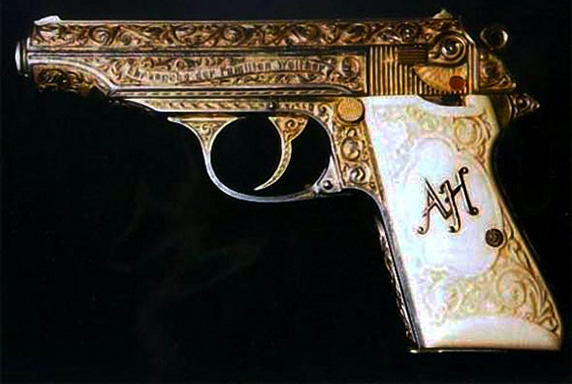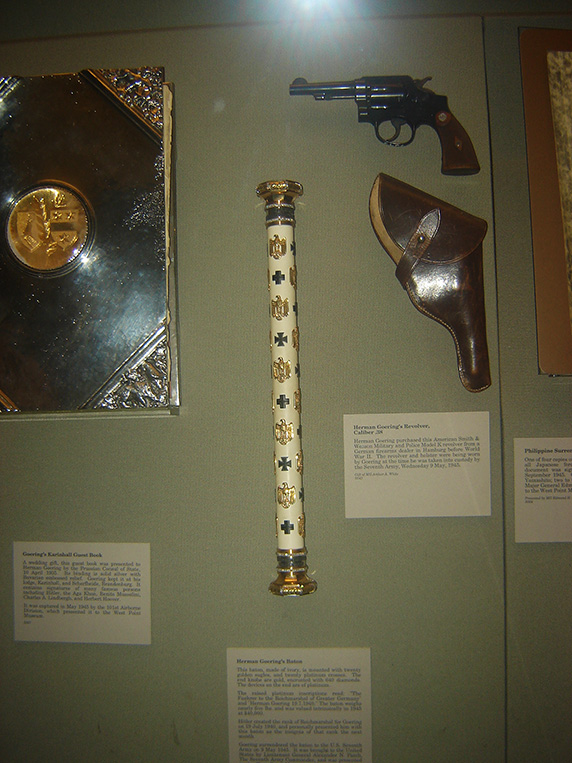There were many strange and notable artefacts hidden and recovered during World War II. We’re looking at a few notable examples, from Hitler’s golden gun to an Ice Cream Barge.
The Man with the Golden Gun
On his 50th birthday, in 1939, Hitler received a 7.65 mm Walther PP from Carl Walther, the famous German gunsmith. The weapon was heavily engraved and embellished. Across the white ivory grips “AH” was inscribed. The gun’s inscription identifies it coming from Walther, who most probably presented the gift to Hitler personally, as the leader had armed much of his army with Walther P-38 semi-automatic pistols to replace the Luger P-08 pistol.

It’s estimated that the gold pistol could fetch in the region of one million dollars. The weapon was supposedly discovered in Hitler’s old apartment in Munich, in late 1945. However, in the 1980s it was sold to a private firearms collector for over $100,000.
The Jewel-Encrusted Baton
Founder of the Gestapo, Hermann Göring was known for his extravagant tastes and garish attire. For the many posts that he held, he had various uniforms designed. His Reichsmarschall uniform included a jewel-encrusted baton. He possessed two different batons. The first air force baton was awarded to Göring after his promotion to Field Marshal. It is now held at the National Infantry Museum at Fort Benning, Columbus, Georgia. The second baton was the only Reichsmarschall baton, which he received in 1940. The shaft was white elephant ivory; the end caps incorporated platinum in the inscription banding and it contained over 600 small diamonds. While it was manufactured for 22,750 RM in 1940, the equivalent today would be about 130,000 USD. It is now US Army’s West Point Museum, Highland Falls, NY.
Hermann Göring's baton, revolver, and guestbook from his residence at Carinhall. By Patxi Aguado

General’s Motors
General Patton used many vehicles during World War II, some of which are displayed at the Patton Museum of Calvary and Armor at Fort Knox, and the Quartermaster Centre at Fort Lee, Virginia. At Fort Knox, the last jeep issued to and used by General Patton is on display. This was modified by adding special front wings, doors, and cushioned seats. Here there is also the 1939 French-assembled Cadillac, which was riding when he sustained the injury that led to his death.
Mercedes Benz 770 (W07) on display at the 1931 Berlin Motor Show. Bundesarchiv, Bild 102-11249

Hitler owned a number of Mercedes-Benz vehicles, many of which are now in the hands of collectors. One of these was a convertible that, on July 8, 1940, was driven from the Daimler-Benz AG factory in Stuttgart and delivered to the Reichs Chancellery car pool in Berlin. On May 5 or 6, 1945, Technical Sergeant Joe Azara of the 20th US Armored Division fought their way towards Salzburg and noticed a large car secured by wire ropes on a flat-bed railway wagon near the town of Laufen. Azara’s friends helped him unhitch the car, which they then drove away. The vehicle eventually ended up FINISH.
Crown Jewels
Safeguarding a county’s gold reserves during the war as well as securing their most precious items was a top priority. In particular, there is a lot of speculation surrounding Great Britain’s Crown Jewels. In 1939, the national treasures of Great Britain were removed from the national Gallery and Hampton Court to be stored in a quarry in Wales. The Crown Jewels, however, were stored in a secret location until 1945.
George I’s state crownBy FASTILY

Speculation says that the Crown Jewels must have been somewhere in the UK, as it was illegal to take them abroad. They could have still been stored in the Tower of London, though the British government claims that jewels were moved to a secret location, which may rule that out. Another possibility is Garrad’s vault, the oldest jewelers in the world, who crafted the jewels. One more location could have been a country estate of one of the senior members of the Royal Household.
Mussolini’s Violin
After his rescue, Mussolini took up residence in the Villa Feltrinelli on the western shore of Lake Garda to rule over the newly formed Fascist Republic of Salò. He was guarded by up to 30 SS soldiers at all time, and considered himself more of a prisoner than a ruler. On April 18, after leaving his villa for the last time, he was captured and executed by partisans. Two days later, the US 10th Mountain Division took possession of the Villa Feltrinelli. The majority of Mussolini’s possessions were “souvenired”.
Mussolini and his violinFrom Wikimexico

One of these souvenirs was his 300-year-old violin. Mussolini was an accomplished violinist, playing duets with his fourth son. The violin itself was crafted around 1700 by Hieronymus Amati. He grandfather Andrea is considered to have invented the violin in the 16th century. The instrument went up for auction at Bonhams, selling for $150,000.
Ice Cream, You Scream
One of the more unusual ships constructed during the war (and there were a few) was an American Ice Cream Barge. Its sole responsibility was to carry frozen goods to US sailors in the South Pacific during the war. Among ice cream, it served other frozen foods to troops who had grown weary of dry rations. The ship was capable of turning out more than a gallon of ice cream a minute.
An example of a concrete shipCredit to WW2pacific.com
